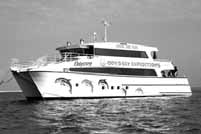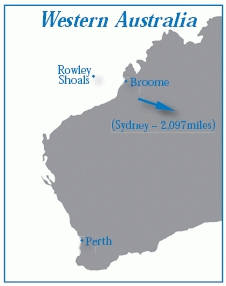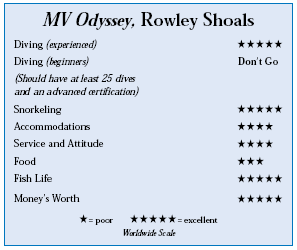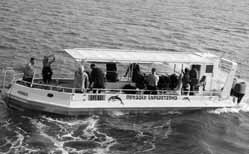MV Odyssey, Rowley Shoals, Western AustraliaContents of this Issue: MV Odyssey, Rowley Shoals, Western Australia Bonaire, California, Fiji, New Liveaboards Hawaii Takes a Bite Out of Shark Tours The Hidden Costs of Dive Travel Heavy Breather? Add 15 Minutes to Your Underwater Time Editorial Office: Ben Davison Publisher and Editor Undercurrent 3020 Bridgeway, Suite 102 Sausalito, CA 94965 great diving Down Under from the April, 2007 issue of Undercurrent
Dear Reader: After a 17-hour overnight steam from the pearling port of Broome, Captain Dave Abbott expertly guided the MV Odyssey through a narrow channel. Bottlenose dolphins served as escorts on both sides of the boat, guiding us to open ocean, when someone shouted, “Whale!” I saw a huge humpback leisurely roll by on his way toward the horizon. A typical day at Rowley Shoals. When I told people I was going diving in Australia, they inevitably thought I was going to the Great Barrier Reef. But after 40 years of diving, I’ve “been there, done that” at many resorts and liveaboards, and I wanted to try something different. So I headed in the opposite direction, towards the northwest, to dive a location so remote and inaccessible that fewer than 400 divers a year are privileged to see it. The kind of diving I like is sheer walls covered with colorful coral and interesting critters, and buffeted by currents. Rowley Shoals had that in spades.
I also had to watch my wallet, so I needed a liveaboard promising good diving on a moderate budget. That’s how I became one of three Americans, 17 Australians, and four crew members aboard the 80-foot catamaran Odyssey. A six-day Odyssey Expedition trip costs less than half that for North Star Cruises’ yacht True North. It also lacks the luxury, crew-to-guest ratio and helicopter rides, but it visits the same dive sites and lets experienced divers explore them solo. The boat, launched in February 2006, only offers Rowley Shoals trips in October and November.
At Mermaid Wall, I hit the water and dropped to 50 feet. I went to investigate a four-foot round leather coral but before I could fully appreciate it, the current whisked me on. Above me, bluefin trevally and purple soft coral shared space in a crevasse. I spotted a six-foot gorgonian and wanted to inspect it for pygmy sea horses but I blew past the wall. Then the water slowed enough to appreciate the 150-foot visibility and a school of Moorish idols over a tabletop-sized plate coral with purple sea fans beneath. I was shocked out of my reverie when I turned my head and found a sixfoot sea turtle observing me from a couple feet away. We made eye contact, then it dropped its left flipper and banked away. I came up and was welcomed by Tess and Captain Dave onto Homer, a 38-foot dive boat moored at Mermaid Reef for the two-month season and used for most dives. The Odyssey definitely needs more staff -- half its crew is away from the boat on every dive, with no divemaster to spare for guided dives and handholding. Because Odyssey Expeditions owners Nick and Lori Linton run a budget dive operation with small salaries, they said it’s hard to hire more when Western Australia’s labor shortage means dishwashers earn more than divemasters. But it was obvious the crew loved what they did, and their smiles were infectious. Dave is around 30, competent, friendly and a good communicator. Every evening, he would explain the next day’s schedule in a casual, humorous way. Tess is in her early 20s and had been with Odyssey Expeditions since August. She did not dive with us, though she did offer to if anyone asked. She was cheerful but inexperience showed through at times. On the first dive at Cod Hole, she drew a picture and explained the direction of the currents, but she was corrected by a diver who had done the trip before on another boat. She stopped using drawings but gave short explanations of underwater terrain and recorded air levels, depth and time for the bends. The Odyssey had an annoying rule that openwater divers couldn’t go below 65 feet and the maximum depth for everyone was 130 feet. That didn’t make sense, especially since most guests had a few hundred dives in their logbooks. But it was in Tess’s rulebook of things to say, although she didn’t make it an absolute rule. Most went deeper anyway. The Homer was used specifically for diving, but the crew also had two 16- foot boats for fishing and chores. Once a tank was on board Homer, it wasn’t removed except for night diving or by Nitrox users transferring tanks after each dive. But it’s not a good dive boat. Instead of fitting it nicely against Odyssey’s stern, the crew placed fenders in between to hold the two boats apart. That meant I had to step over the two-foot high line attaching them, then lean over three feet to grasp a rail on Homer with one hand while keeping the other hand on Odyssey, and then carefully transfer my weight down. Homer is equally frustrating at sea. Tanks slide into slots running down the boat’s center with benches on each side. To get my tank in, I had to stand on a bench, hoist the dive system up over the back of the bench and drop it into the slot. To put the tank on, I had to place it on the 18-inch bench, which left only 10 inches to sit on and wiggle into my BC. One diver punched two holes in his BC removing it from the center slot. Getting my fins on was also a challenge because there isn’t enough deck space near the bench. Odyssey’s stern deck had benches with tanks on both sides and storage space
for equipment underneath. A ladder on each side leads to a platform for entering
the water but I only used the back deck for a night dive. I had to use air
because they only had two 95-cubic-foot and two 75-cubic-foot Nitrox tanks, and
two other divers had already reserved the 95s. In shallower water warmed to 86°, the live coral decreased by half. At 50 feet, where the water temperature was 84° or less, the coral was thriving. Still, the limited number of annual divers had left coral gardens untouched. No dive was boring. It was either a scale of sheer vertical wall, a sweep through deep canyons on high-speed drifts, an exploration of Technicolor coral bommies in turquoise lagoons, sometimes all three on one dive. Most fish had no fear. At Clerke Reef’s Blue Lagoon, large maori wrasse foraged on the reef, and trevally, mackerel and tuna hovered in schools nearby. Reef sharks were curious but not enough to get close for a photograph. I chose to buddy up with Darryl, a mild-mannered Australian businessman in his mid-fifties from Fremantle. He was fearless except when it came to cuttlefish. That’s because one evening at dinner, a gregarious Australian guest told us about a diver chasing a lobster into a cave where a cuttlefish rested. The cuttlefish became agitated, rushed straight at the diver, wrapped its arms around his head, and bit his nose, making him bleed to death. The next day, Darryl and I came upon two large cuttlefish, but Darryl obviously had the dinner story on his mind. One cuttlefish undulated its fins and approached Darryl -- the perfect photo situation -- but Darryl’s eyes dilated as he gyrated his fins and backed well away. Afterwards, Darryl said he knew I wanted a photo but had no desire to provoke a fatal nosebleed. The Odyssey sleeps up to 20 people, with six deluxe doubles and four twin shares. Roomy deluxe cabins offered two single beds that could join to make a double, a sink, desk and storage cabinets. My standard cabin was downstairs in the starboard hull with two comfortable bunks, two standup storage cabinets and storage space above. Each cabin had a small refrigerator that kept drinking water cool. Cabin towels and bed linens were not changed during the week, but the crew did personal laundry upon request. Four rooms with showers, toilets and sinks are against the back deck. I didn’t have to wait long to use one, and it kept extra moisture out of my cabin. But because they were situated over the generator, compressor and engines, they were always hot. It was also impossible to get cool water for a shower because the freshwater storage tank in the engine room kept the water continuously warm. After changing out of my dive gear, I walked to the deck upstairs that had a half-shaded area with three picnic tables and a little bar that always had a five-gallon bottle of drinking water and an ice chest with cold soft drinks. A door led to the air-conditioned dining salon where meals were served buffet style on tables for six. Kylie the cook, an upbeat woman in her thirties, served solid, nutritious food, but it lacked imagination. I doubt she considered herself a professional chef. Still, the Australian guests either didn’t notice the food quality or didn’t care, and they dug into every meal with gusto. Kylie set up a continental breakfast of fruit, toast, cereal, yogurt, juice, and coffee before the first dive at 7 a.m. Every other day was a cooked breakfast of omelets or pancakes and bacon. The second dive at 10 a.m. was followed by lunch, typically a main dish like tuna casserole with salad and bread. After the mid-afternoon dive at 2 p.m, scones and fruit were served as snacks. The night dive or late afternoon dive was before dinner, typically grilled meat, salad, fruit salad, and pasta salad. A handy machine always offered hot water for tea, cappuccino, coffee and espresso. The boat sold beer and wine, but most guests brought and shared their own. Three night dives were offered. I did the first one at Cod Hole. A moment after I descended, a five-foot potato cod came up to me with big, friendly eyes. I put my hand on its side as it slid past, turned and came back for more. Finally satisfied, it moved to a cleaning station where wrasse and shrimp scampered around its head. I moved on to take pictures of clownfish on an anemone. When Darryl showed me he was down to 700 p.s.i., we headed back to the boat but the current had really picked up. We swam to the reef and decompressed at 15 feet, holding on to a piece of dead coral and flapping in the current like two flags in the wind. Our swim back was across the current but Kim, the engineer, was wisely standing by in a fishing boat to pick up anyone having trouble. I skipped the other two night dives because they were inside the atoll where visibility was poor. Kim was usually in the engine room but friendly and helpful. When one diver had problems with his new regulator, Kim tried to fix it but it was a manufacturer’s defect and another first stage was needed. I was surprised to find the boat did not have spare dive equipment, so another guest lent the diver a first stage for the rest of the trip. Kim also couldn’t fix the air conditioner, which stopped working on the starboard side during the third night, making sleeping hot and uncomfortable. Captain Dave asked everyone to leave cabin doors open to let the functioning air conditioning cool both sides. It worked but was not a perfect solution. Two guests were snorkelers, and one called their experience drifting atop Mermaid Reef “the best snorkel of my life.” So I joined them for the second time there. Thousands of foot-long garfish reflected the sunlight, changing from silver to blue as they formed a circle around me, with yellow and black sergeant major fish joining in. I snorkeled to 12 feet and listened while a herd of 100 oblivious egghead parrotfish crunched coral. The reef had many crevasses, one with a big piece of brain coral hanging over it, so I held my breath and investigated the dark hole. A big snapper allowed a fleeting glimpse before retreating further in. Even though I saw sharks on every dive, snorkeling with them was better because they were more relaxed and lingered longer when air bubbles weren’t around. Two white-tip reef sharks let me get within six feet before moving off.
While the Odyssey moved from Mermaid Reef to Clerke Reef on the third day, I visited the high-tech helm. It features the latest navigation and communication equipment, including a connection to the large-screen TV in the dining salon that showed the boat’s position when we were moving. From the helm, steps descended to the bow of the boat and benches, where I spent a pleasant evening sipping wine and singing songs while one diver played his guitar. On another evening at Clerke Reef, we went to the white-sand beach at Bob’s Island, where I enjoyed wine, observed a nesting red-tailed tropic bird, and was treated to a glorious sunset. The next morning at Clerke Reef, everyone decided to snorkel Rollercoaster, a drift on the inside of the reef through Clerke Reef channel. It started out as a calm swim over turquoise shallows surrounded by lace coral fronds, delicate as ballerinas. The coralscape moved faster below me as the current picked up with a high, outgoing tide. As I blew through, I saw white-tip sharks, staghorn coral, redfin butterflyfish, ornate butterflyfish, Teira batfish, and a blue-girdled angelfish. I was propelled out of the lagoon to the edge of an abyss that plunged below into inky midnight blue. The final dives were less adrenaline-pumping and more mellow explorations of caves, crevices and alleys in the outer reef before an overnight steam back to Broome. Drift diving at Clerke’s and Mermaid’s walls offered constantly exciting surprises and even jaded divers will find Rowley Shoals worth the jet lag, expense and time commitment to visit during its short season. Inexpensive land excursions near Broome, Darwin and the Kimberley are also worth building into trip time. Experienced divers preferring low costs over luxury will fare best, especially since they must be capable of looking after themselves in the water, dealing with the poorly designed Homer, and helping with the physical tasks of transferring diving equipment and luggage. Odyssey is a new, clean boat but its food and AC breakdowns make it far from luxurious, and it needs some remodeling to better serve divers. The crew, though short-staffed, made up for most shortcomings with positive attitudes and friendly help. North Star’s boat may offer gourmet food and helicopter rides, but for those most concerned about what’s underwater, the Odyssey offers a budget-friendly trip to one of the world’s top dives. --M.P.
|

I want to get all the stories! Tell me how I can become an Undercurrent Online Member and get online access to all the articles of Undercurrent as well as thousands of first hand reports on dive operations world-wide
| Home | Online Members Area | My Account |
Login
|
Join
|
| Travel Index |
Dive Resort & Liveaboard Reviews
|
Featured Reports
|
Recent
Issues
|
Back Issues
|
|
Dive Gear
Index
|
Health/Safety Index
|
Environment & Misc.
Index
|
Seasonal Planner
|
Blogs
|
Free Articles
|
Book Picks
|
News
|
|
Special Offers
|
RSS
|
FAQ
|
About Us
|
Contact Us
|
Links
|
3020 Bridgeway, Ste 102, Sausalito, Ca 94965
All rights reserved.


 Captain Dave set anchor inside Mermaid Reef as
Kylie, the cook, prepared the dive boat and divemaster
Tess Harry gave details about the dive, a
one-mile drift along Mermaid Wall. Mermaid Reef
is one of three coral atolls that make up Rowley
Shoals, 186 miles offshore from Broome in Western
Australia. They rise almost vertically from 1,300-
foot depths. The three are equidistant from each
other and nearly alike -- 10 miles long, five
miles wide, with a channel deep enough to navigate
to a shallow lagoon. The Odyssey went to Mermaid
Reef, the most northerly, then Clerke Reef, but
did not visit Imperieuse Reef.
Captain Dave set anchor inside Mermaid Reef as
Kylie, the cook, prepared the dive boat and divemaster
Tess Harry gave details about the dive, a
one-mile drift along Mermaid Wall. Mermaid Reef
is one of three coral atolls that make up Rowley
Shoals, 186 miles offshore from Broome in Western
Australia. They rise almost vertically from 1,300-
foot depths. The three are equidistant from each
other and nearly alike -- 10 miles long, five
miles wide, with a channel deep enough to navigate
to a shallow lagoon. The Odyssey went to Mermaid
Reef, the most northerly, then Clerke Reef, but
did not visit Imperieuse Reef. The boat couldn’t provide more Nitrox because of a slow,
labor-intensive method of filling
tanks, and it charged $12
U.S. for each fill. The Odyssey also didn’t have underwater
photographers’ needs high on
their list. Nothing was mentioned
in the initial briefing.
My photo system and another
diver’s video system were kept
on a small seat next to Captain
Dave on the dive boat. I don’t
know where additional large
photo and video systems would
have been kept if there were
more photographers. When I asked
where the photo table was, Tess
said to use one of the picnic
tables on the upper deck, meaning
I worked on my photo system
beneath a roasting sun.
The boat couldn’t provide more Nitrox because of a slow,
labor-intensive method of filling
tanks, and it charged $12
U.S. for each fill. The Odyssey also didn’t have underwater
photographers’ needs high on
their list. Nothing was mentioned
in the initial briefing.
My photo system and another
diver’s video system were kept
on a small seat next to Captain
Dave on the dive boat. I don’t
know where additional large
photo and video systems would
have been kept if there were
more photographers. When I asked
where the photo table was, Tess
said to use one of the picnic
tables on the upper deck, meaning
I worked on my photo system
beneath a roasting sun.
 Diver’s Compass: The ideal weather for Rowley Shoals is October and
November ... From June through September, Odyssey takes 10- and
12-day trips through the Kimberly north of Broome ... Deluxe cabins
cost $2,052 per person; I paid $1,888 for a standard cabin ...
The flight from L.A. to Sydney took 13 hours and air travel from
Sydney to Perth was 4 hours; a round-trip fare to Sydney via Qantas
is approximately $1,400 in October-November ... To Broome, Air
North (
Diver’s Compass: The ideal weather for Rowley Shoals is October and
November ... From June through September, Odyssey takes 10- and
12-day trips through the Kimberly north of Broome ... Deluxe cabins
cost $2,052 per person; I paid $1,888 for a standard cabin ...
The flight from L.A. to Sydney took 13 hours and air travel from
Sydney to Perth was 4 hours; a round-trip fare to Sydney via Qantas
is approximately $1,400 in October-November ... To Broome, Air
North (